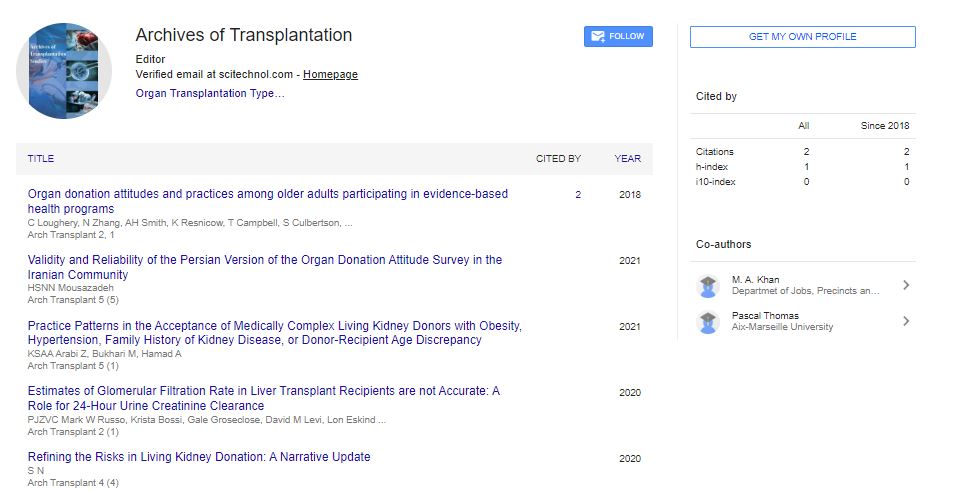Commentary, Arch Transplant Vol: 5 Issue: 5
Human Leukocyte Antigen and Undifferentiated Cell Transplantation
Akihiko Hasegawa*
Department of Orthopedic Surgery, Osaka Medical College, Daigaku-machi, Takatsuki, Osaka 569-8686, Japan
*Corresponding Author: Hasegawa A, Department of Orthopedic Surgery, Osaka Medical College, 2-7 Daigaku-machi, Takatsuki, Osaka 569-8686, Japan, Email:ort171@osaka-med.ac.jp
Received date: September 01, 2021; Accepted date: September 15,2021; Published date: September 23,2021
Keywords: Human Leukocyte Antigen
Introduction
The short arm of chromosome 6 contains a group of qualities known as the significant histocompatibility complex (MHC) or the Human Leukocyte Antigen (HLA) area. Undifferentiated cell transplantation can be done between kin who are HLA indistinguishable or can be demonstrated to be coordinating by various procedures of DNA examination. In decreased power molding relocate systems, the contributor is treated with drugs or potentially radiotherapy at lower dosages than those utilized for standard SCT. A significant postâ?transplant confusion is response of the immunocompetent cells in the join against the tissues of the host, causing Graftâ?Versusâ?Host Infection (GVHD), which can be intense or constant. Postâ?transplant lymphoproliferative problems (PTLDs) are polyclonal or monoclonal lymphoid expansions or lymphomas that happen in beneficiaries of foundational microorganism or, all the more as often as possible, strong organ allografts, because of the immunosuppression. Hematopoietic Foundational Microorganism Transplantation (HSCT) has become progressively acknowledged as a helpful methodology for an assortment of dangerous and nonmalignant conditions. Illnesses treated utilizing HSCT can be separated into threatening and nonmalignant conditions. Foundational microorganisms for allogeneic transplantation are gathered from bone marrow, fringe blood, or umbilical string blood, while undeveloped cells for autologous transplantation are gathered most ordinarily from fringe blood. Numerous other minor histocompatibility edifices are significant in the resistant reaction; notwithstanding, current benefactor coordinating for HSCT is restricted to class I and II atoms. Due to the pretransplant preparative routine, patients will have a lengthy time of anorexia requiring all out parenteral sustenance. The significant immunosuppression that happens both previously, then after the fact engraftment puts HSCT patients at high danger for contamination with an assortment of life forms. Indeed, even with the recuperation of white platelet counts and explicitly lymphocyte counts, HSCT patients require a very long time to years to recuperate safe capacity. Allogeneic Undifferentiated Cell Transplantation (ALLOSCT) has a remedial potential in patients with relapsedâ? refractory nodal and cutaneous T Cell Lymphoma (TCL). Hepatosplenic Tâ?cell lymphoma (HSTL) is an extremely remarkable subtype; in this way, there is absence of agreement with respect to the ideal enlistment and solidification treatment to suggest. The clinical indication of ATLL is heterogeneous and incorporates four subtypes: intense, lymphomatous, ongoing, and seething. Lately, the utilization of quality articulation profiling/entire genomic sequencing has given understanding not just concerning the distinguishing proof of various lymphoma subtypes yet additionally information for a superior prognostic delineation. The decision of sort of solidification following enlistment treatment ought to thusly think about these new prognostic elements. Moreover, there are studies investigating the job of fanciful antigen receptor T cells in Tâ?cell lymphomas. Haemopoietic foundational microorganism transplantation addresses a significant and progressively used remedial treatment in hematological malignancies and plays an arising part in the administration of patients with haemoglobinopathies and bone marrow disappointment. Autologous transplantation stays a significant treatment technique in patients with myeloma and backslid lymphoma. Infection backslide stays the significant reason for treatment disappointment after autologous SCT. Enhancements in steady consideration and treatment of post-relocate difficulties, a more noteworthy accessibility of elective contributors and advances in tissue composing have all the while worked on the quantity of patients qualified for allogeneic transplantation and relocate result. The acknowledgment that an immunologically intervened join versus-leukemia impact makes a significant commitment to the remedial impact of an allograft has prompted the improvement of diminished force molding regimens, which have considerably decreased the dismalness and mortality of allografting. Advances in the distinguishing proof of patients whose result with standard chemotherapy is probably going to be poor combined with an expanded consciousness of the effect of pre-relocate co-morbidities on persistent result has helped patient determination. The significant difficulties in allogeneic SCT are presently the plan of systems which can decrease the significant reasons for relocate harmfulness mainly intense and constant join versus-have illness and sickness backslide which currently addresses the significant reason for therapy disappointment
 Spanish
Spanish  Chinese
Chinese  Russian
Russian  German
German  French
French  Japanese
Japanese  Portuguese
Portuguese  Hindi
Hindi 